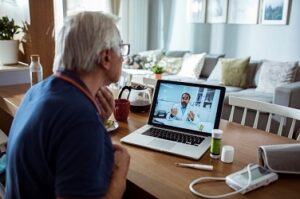Telehealth Tips for Older Adults

The Benefits of Telehealth
Even before the pandemic, the use of telehealth was growing—popular mostly among younger patients. But by the end of 2020, many seniors also had warmed up to telehealth, seeing their doctors online from the comfort and safety of their own home or senior living community.
Studies confirm the rapid increase in the use of telehealth among older adults. A recent poll conducted by the University of Michigan Institute for Healthcare Policy and Innovation (UM) found that in 2019, only 4% of people older than 50 had ever had a telehealth appointment. But early in the pandemic, that number rose to 30%, and according to a March 2022 poll from Independa, 75% of older adults have now attended a telehealth appointment. There is even a government portal for patients, telehealth.hhs.gov/patients.
The Independa survey revealed that avoiding exposure to COVID wasn’t even the top factor in acceptance of telehealth among older adults and family caregivers. Instead, comfort and convenience topped the list, followed by saving travel time.
Doctors, too, found that for some types of visits, telehealth was efficient and offered a number of advantages. “This has been an extraordinary time for the telemedicine movement, and these poll results show just how powerful this ‘trial by fire’ has been,” says UM’s Dr. Jeff Kullgren, who uses telehealth with his patients at the VA Ann Arbor Healthcare System. “But our data also highlight areas of continued concern for patients that need to be addressed.”
Meeting Telehealth Challenges
Telehealth is great for people who have trouble getting to the doctor’s office. It offers a lot of promise for rural seniors. But barriers remain. Experts from University of California, San Francisco (UCSF) say that more than a third of older adults face impediments to using telehealth.
Some don’t know how to operate the equipment—or, they don’t have access to it. Others have hearing or vision impediments, or difficulty speaking. People with dementia are at a particular disadvantage.
And it’s not just a matter of seniors adapting to this new technology. The technology must adapt to older users, as well. “To build an accessible telemedicine system, we need actionable plans and contingencies to overcome the high prevalence of inexperience with technology and disability in the older population,” said UCSF study author Dr. Kenneth Lam. “This includes devices with better designed user interfaces to get connected, digital accommodations for hearing and visual impairments, and services to train older adults in the use of devices.”
Tips to Help Older Adults in Telehealth Appointments
To help older users take advantage of remote doctor visits, the National Institute on Aging shares 10 tips for a better telehealth appointment:
- Once your online appointment is confirmed, add it to your calendar so you don’t forget.
- Use the best camera you have, whether it’s attached to your phone, laptop, tablet, or desktop computer. Clear video and sound can help your doctor understand and address your concerns more easily and effectively.
- Test the sound and video on your device. Most devices have built-in microphones and speakers, but you may have to turn them on or enable the telehealth software or website to access them.
- Using headphones or earbuds may make it easier for you to hear your doctor and for your doctor to hear you.
- Do a test run, practicing beforehand with a family member or friend to be sure that everything is working properly, that you’ve chosen the best equipment and settings, and that you understand how to use your camera when you have your online visit with your doctor.
- Use the best internet connection possible. If you are not using Wi-Fi, try getting the best signal by using a wired connection to your router or an Ethernet cable. If you are using Wi-Fi, being physically close to the internet router and minimizing devices connected to it can help improve your connection.
- Charge your device. If you are using a wireless device, like a phone, laptop, or tablet, check to make sure your battery is charged enough to last through your appointment. Try charging it the night before your appointment.
- Find a quiet space and adjust lighting. Limit distractions and clutter in your space. Choose a place with good lighting so your doctor can see you properly.
- Position yourself. Place your device on a sturdy surface so you can move around if you need to. Try positioning your device so your head and shoulders are in the camera frame.
- Prepare a list of questions and concerns. Just as is true during an in-person appointment, this will make it easier for you and your doctor to cover everything you need to talk about.
- Have prescription medication containers on hand if a medication review is planned.
A second University of Michigan study stresses that family caregiver support can help older adults have a better telehealth experience. “In many cases, getting into the visit requires multiple clicks, requires knowing how to use a computer, turning on the microphone, turning on the speakers, being able to hear,” reported study author Minakshi Raj. “Some caregivers described their older relative’s hearing difficulties, and so it just became more frustrating because they couldn’t hear what the doctor was saying through the computer. In terms of telehealth policy and practice, we need to start thinking about how we can better engage caregivers so that they can still stay involved, better support their relatives and also be better supported by the health care system.”
The information in this article is not intended to replace the advice of your health care provider. Talk to your doctor and your insurance company to find out if telehealth is right for you.

